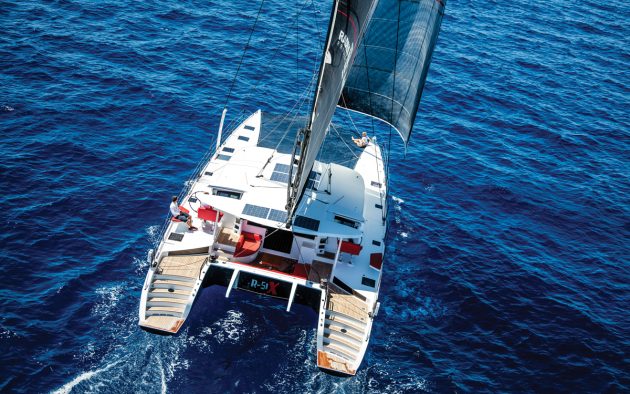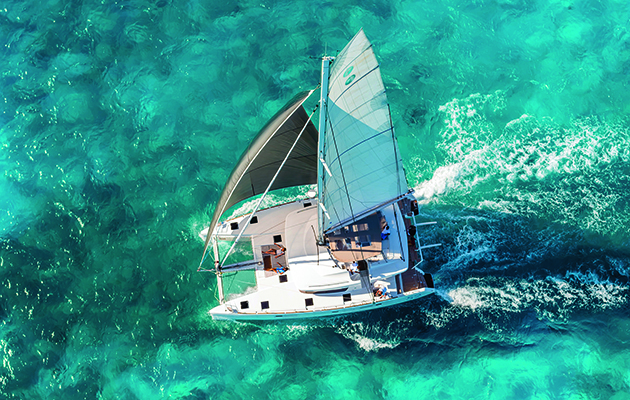Round the world sailor and record holder Brian Thompson is in demand among performance cat racing teams and cruising owners for his multihull skills. He has tips for Andy Rice on switching from one hull to two
For a keelboat sailor, switching to a multihull, especially a performance type multihull, for the first time requires a significant shift in thinking about some of the fundamentals in sailing. There’s no lead keel bulb to get you out of jail if things start going wrong, so your attitude to risk has to change. A lighter, more responsive type of sailing boat requires a different relationship with the wind and the water.
Who you sail with is also important. On a keelboat, more crew is generally better, even if the less experienced are only there for extra ballast. On a performance multihull you’re looking to keep the overall weight down so you’ll be sailing with fewer crew, which means that every crew member needs to count. You want to have as many multi-skilled sailors on board as possible, capable of stepping into any role.
1. Know your limits
On a keelboat, if things go badly wrong you might end up broaching. On a multihull, things going badly wrong can result in a capsize – and it can all happen very quickly. You have to know well before things are likely to start going wrong, which is why it’s vital to have relevant multihull experience on board.
For example, sailing downwind in strong wind and big waves you might notice the bows pushing down one or two degrees more than usual, which is one of the early warning signs to start backing off.
2. Don’t stress the boat
You also need to be sensitive to the structural limits of the boat. It’s easy to overstress a high-performance multihull. Structurally you need to know when to back off. You can’t always afford to drive full-bore into the back of big waves in 25 knots of wind. On the old PlayStation catamaran we’d be restricting our speed around 50% of the time because our performance was so limited by sea state.
Trimarans tend to be able to take more because they’re stronger structures by their very configuration. Their hulls tend to be thinner and cut through the water more easily than the hulls of a catamaran, and trimarans tend to hobby-horse through the waves less too.
3. Learn your angles
Lightweight multihulls are capable of generating enormous amounts of apparent wind, and easily capable of exceeding windspeed. Downwind even heavier cruising multihulls respond to sailing the angles, so you need to get used to heading up initially to build the apparent wind across the sails and then bearing away only once you’ve built up speed.
Yes, you’ll sail extra distance to start with, but you’re rewarded by the huge gain in efficiency once you’re up to pace. Multihulls are generally faster than keelboats, so tide and current are less of a factor but are still important. If beating into adverse current you might not do as much short tacking – partly because you’re making better speed through the water but also because manoeuvres are more costly.
In a lightweight multihull, you might actually look to sail into the adverse current, which is counterintuitive but can work wonders. If there’s 10 knots of true breeze with slack current on one side of the course and 2 knots of adverse current on the other, sailing into the current would give you 12 knots of measured wind, and the additional 2 knots of windspeed might take your boatspeed up to, say, 16 knots compared with only 13 knots of boatspeed in slack water.
4. Less (sail area) is more
Because multihulls are light and take less power to get them fully up to speed, proportionally you don’t need as much sail area as a keelboat would want. Not only will reducing sail in strong winds make the boat easier to handle, reducing the risk of capsizing or pitchpoling downwind, but because you’re flying along at high speeds you actually want less sail area for reduced aerodynamic drag too. Having sail flapping around is way slower on a fast boat than on a slow boat like a conventional keelboat.
Article continues below…
Catamaran Sailing Techniques: Everything you need to know
The attraction of sailing a boat that offers the vast living space found on a catamaran may one day mean…
Performance cruisers: the best new catamarans for racing and fast cruising 2018
This is where the worlds of racing and cruising multis meet, where we see high-tech lightweight craft that use exotic…
5. Aim for neutral helm
A bit of weather helm can be a good thing on a monohull, maybe up to 5° of angle on the rudder when sailing upwind. On a multihull you don’t want any, because at higher speeds it’s all just drag. So you want the rudder as neutral and balanced as possible.
It’s worth setting up the sails to help you achieve that neutral helm. You need to think about your exit route if the breeze puffs up, so upwind you want to go big mainsail and small jib, to make the natural tendency of the boat to be to want to luff up in a gust. Downwind you want to go with a reefed mainsail and big headsail so that the boat naturally wants to bear away in a gust.
 About the author
About the author
Brian Thompson is one of the most in-demand professional sailors on the grand prix scene. He has raced solo in an IMOCA and helped steer ABN Amro One to victory in the Volvo Ocean Race, but is perhaps best known for his prowess in high-speed multihulls.






